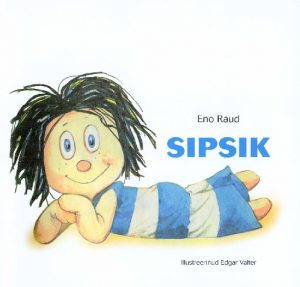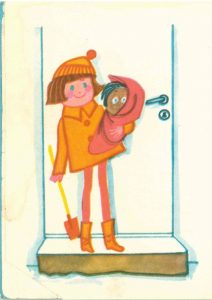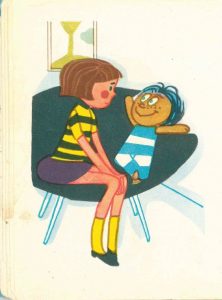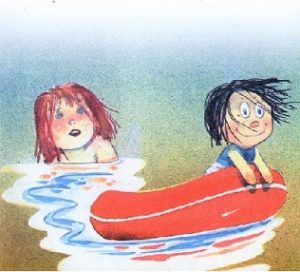*
The following piece is in two parts: a brief critical essay (I) and a translation (II). The essay was first presented at an academic conference (“Locating Post-45,” University of Pennsylvania, Spring 2015), and a few references to its original occasion have been retained.
*
Part I: Essay
Sipsik: A Soviet-era Estonian Children’s Book between Nationalism and Ideology
On finishing up an “extracurricular” project (I am a Romanticist, currently writing a dissertation on William Wordsworth), a new English translation of Eno Raud’s Sipsik (Tallinn, 1962), an enduringly popular Soviet-era Estonian children’s book, and considering its chances for US publication, I found myself anticipating the ambivalent reactions: This lovely story is too quiet and too circumscribed for a contemporary North American audience—too quiet for, say, five- to eight-year-olds who may already have acquired a “thirst after outrageous stimulation” and too circumscribed for parents who prefer that the narratives offered their children engage, however distantly, with social realities.[i] The story, of a five-year-old girl and her imaginary companion, unfolding against the backdrop of the daily life of a sketchily, if realistically, rendered immediate family, might seem to float in some just slightly exotic and geographically unplaceable (because of unfamiliar personal names and a few details of setting) but otherwise comfortably familiar world of an idealized postwar, urban, petit-bourgeois domesticity.
The irony is that, while the book might well succeed on just these terms for a contemporary Western audience, because of the exceptional sensitivity and naturalness of the handling of the theme of an imaginary companion (about which more below), I had come to see just these qualities, of quietude and circumscription, as deeply politically entangled, indeed as reflecting strategies of nationalist resistance to an encompassing imperial order. The tip-off, so to speak, for regarding the book in this way, for one not wholly immersed in Soviet history, came in certain details where it seemed certain that the text was indeed reaching out, referentially—engaging with censorship, gently satirizing the inescapability of state propaganda, or alluding to one of the most obtrusive aspects of military occupation. If a quick look at two such details, as follows, is preliminary to my larger point, concerning the emancipatory uses to which “nuclear family romance” might be put in certain contexts,[ii] it nevertheless provides an opportunity to sketch in some background to what is likely an unfamiliar time and place.
— Sipsik, young Anu’s imaginary companion, is a rag doll that comes to life with the care of its making, by Anu’s brother for her fifth birthday. The graphic realization of the character (fig. 1, below), makes rather obvious reference to the sinine-must-valge tricolor, the outlawed and largely unseen blue, black, and white flag of the interwar Estonian republic (fig. 2). This at a time when the color combination was banned from, for example, textile and graphic designs and, reportedly, an Estonian-language periodical might be pulled in the midst of a print run and pulped if censors deemed the colors on a cover objectionable in this way. Estonians of my acquaintance who grew up with Sipsik acknowledge the reference, find it indeed surprising, and cannot readily account for it, except to suggest that perhaps for children’s books strictures were looser (and that of course the workings of the bureaucracy had their vicissitudes and in any particular instance could seem arbitrary, unexpected). For some reason there are two sets of illustrations for the text, by the same illustrator. The earlier set, used in the first edition (fig. 3), is executed in a now appealingly retro-hip midcentury style that might be characterized as aspirational Soviet modernism, as the fashion and furnishing styles depicted appear in contemporary publications of the Estonian SSR (especially any intended for tourists) out of all proportion to their appearance on the street or in private domiciles, especially if non-urban environments are accounted for. The second set of illustrations is less obviously stylistically inflected. In the first set, Sipsik is unmistakably black, something I find wholly remarkable, given that the Estonian-language readership is as homogeneously white as can be imagined. We might speculate that the combination of a black main character, flattering to Soviet internationalism, and a graphic style reflecting and promoting Soviet modernist material culture, might have trumped any suspected reference to a banned symbol of the bourgeois republic (which is then more explicit in the second set of illustrations, used for a subsequent edition that appeared in the mid-eighties).
— Among Anu and Sipsik’s adventures together, which comprise a narrative loosely organized around the extremes of the nordic climate through the course of a year, is a day at the beach, during which Sipsik inadvertently teaches Anu to swim. Sipsik begs to be put in Anu’s rubber boat, and then once on the water is seized by a sea fever and sails out of reach of Anu (fig. 4):
“See you later!” yelled Sipsik. “Don’t forget me in the meanwhile!”
Now Anu began to be seriously afraid. Who knew whether Sipsik, suddenly in thrall to dreams of the open sea, might not set sail for a foreign shore. So Anu plunged in, got wet from head to toe and splashed about with her hands, so that she wouldn’t feel the cold so sharply and so that she could better catch up with Sipsik. Then she took some big steps forward. First the water was up to her chest, then to her shoulders, and then almost to her chin. She was nearly caught up to Sipsik, and so she reached out her hands so that she might grab hold of the rubber boat. But just at the last moment, a gust of wind pushed the boat, and Sipsik, a little further away and out of Anu’s grasp.[iii]
And so on, and finally Anu is fully swimming after and retrieving Sipsik. This at a time when the coastline of the “western borderlands” (of which the Baltics were a segment) was fully militarized. There were of course seaside resorts and public beaches (two Estonian coastal towns that developed in czarist times as railroad resorts for the St. Petersburg aristocracy were favored destinations for Party elite from across the Union). But the greater reality was of internal checkpoints and frequent presentation of papers for civilians living close to the coastline, armed watchtowers dotting the western or northern horizon, and a continuous trough plowed along the beach or dunes, beyond which citizens were forbidden to venture.[iv] The Estonian maritime border was especially sensitive because of the proximity of Finland, less than 90 kilometers across the gulf at the narrowest crossing.
And really, that’s it, beyond, possibly, some mild satire on the ubiquity of martial music on state radio, which spooks Anu on her first night at home alone with Sipsik, or on the dearth of programming on state television: For the naïve reader, at least, these details would seem to exhaust the overt political content, subversive or otherwise, of what became the most favored children’s book for the Estonian readership. It’s worth registering, however, what does not appear in the narrative: Anu and family take no meals in a collective kitchen; they celebrate no state holidays; older brother Mart never returns home from Young Pioneer meetings, never sports a red scarf or cultivates a pen pal in a brother socialist republic like the GDR. In these absences, Sipsik is far removed from any text that might have appeared in a formal pedagogical setting.[v]
But perhaps most significant is the absence of any folkloric element. “National in Form, Socialist in Content” was an ideological catchphrase for the sanctioned, ritualized displays of ethnicity that took hold during the Stalinist era and were elaborated after the war, and that reflected the Party’s efforts to address “the lasting political problem of how to represent the Union as a voluntary association of peoples of equal rights and power.”[vi] The delicate cleaving of “bourgeois” nationalism from a properly socialist nationalism depended on the ultimate class equivalence of “folk,” “peoples,” and “worker,” such that the folk could have no political ambitions that were not contained, anticipated, by Marx-Leninist doctrine. It was an ideological formulation that necessarily papered over the history of the Party’s own tortured and tragic relations with the peasantries of the region, from whom the sanctioned representations of folk ethnicity were derived.
Ritualized or stereotypic representation of traditional cultures “formed a useful contrast to the otherwise pervasive and homogenizing style of Soviet modernism.”[vii] It was entertaining, in a word, and it was especially visible in the Estonian SSR (fig. 5). It was also ultimately uncontainable, providing as it did a ready platform and model for the mass actions that precipitated the breakaway of the Baltics in the late eighties and early nineties.[viii]
Soviet folkloric traditionalism had also its literary representation—strong, too, in Estonia—and Eno Raud occasionally worked in this vein, recasting traditional tales for young readers. That Sipsik, the work that brought him his widest, most attentive audience, has no such elements may attest to a political desire among the subaltern that points beyond the collective—a desire for the cultivation of private domestic space.[ix] Or so I would suggest, even if from another perspective Raud’s narrative might be seen less as giving form to desires inexpressible through any publicly available discourse and more as realistically portraying an effect of the accumulating failures of the Soviet economy, which, despite official hostility, forced reliance on local social structures and economies—on family, friends, and kinship networks and “a delicate network of barter and favors”—in the struggle to meet daily needs.[x]
*
But I’ve put myself at some distance from what initially attracted me to Sipsik and what surely accounts for its continued appeal in post-Soviet Estonia: the sensitivity, naturalness, and lack of any hint of pathologizing in the portrayal of a child’s relationship to her imaginary companion. It seemed, in this respect, as likely in advance of any Western children’s fiction from the period (an intuition I have not had the opportunity to test), and as the perfect literary embodiment of British psychoanalyst D.W. Winnicott’s conception, dating from the early fifties, of the transitional object. There is a popular conception of the fate of Soviet psychoanalysis in the Stalinist era and beyond that I cannot here rehearse or attempt to complicate. Raud was likely a Party member (as a member of the writers’ union) in the ranks of the intelligentsia (little biographical information is readily available), and one question opened up by our readings is how he might have intersected with a late fifties–early sixties “Marxist humanism in Eastern Europe [that] had the immanent political agenda of anticolonial resistance to the Soviet Empire.”[xi] A follow-on question, then, is the extent to which Raud might have gathered ideological support for a narrative that so clearly endorses a child’s cultivation of an expansive psychic interiority, or whether the story’s appearance is better understood as a response to more immediate, felt concerns.
I fear I have disproportionately contextualized and not, in this short space, brought forward the text nearly enough to justify my assertion of the exceptionality of Raud’s treatment of the experience of an imaginary companion or to make good on my suggestion that Sipsik might demonstrate, in an unexpected context, the emancipatory political utility of literary domesticity. I end with a gesture toward amends, inviting a reading of a final passage from Sipsik (Part II, below), and asking the reader to consider the successive enfoldings or enclosures—at the outermost, of the Estonian language, already half-private within the colonial context, and, at the innermost, a box or drawer, gently closed with the pledge “Surely we will manage somehow.”
One linguistic note: The Estonian language has no gender, not even gendered pronouns. A few chapters into this translation I shared it with some Estonian friends and was quite surprised to learn that Sipsik is (seemingly universally considered) a boy. I have nonetheless stuck with my initial impulse. With this publication, then, Sipsik becomes to my knowledge the first transatlantic, transgender Estonian imaginary companion.
_________________________
Notes:
[i] “Thirst after outrageous stimulation”: William Wordsworth, preface to Lyrical Ballads (1800).
[ii] The reference is to, from the readings for this conference, Jed Esty and Colleen Lye, “Peripheral Realisms Now,” Modern Language Quarterly 73, no. 3 (2012): 283. I mean to complicate, it will be clear, Etsy and Lye’s aligning of such fictions, necessarily, it would seem, with forces of reaction, as here: “Recoding peripheral modernisms as realist…raises the possibility of touching base with the collective protagonists of subaltern political desire…without stopping at the way station of bourgeois consciousness or middle-class domesticity” (281).
[iii] Eno Raud, Sipsik, illustrated by Edgar Valter (Tallinn: Tammerraamat, 2010 [1962]), 63–64 (my translation). Passages from Sipsik by permission of Aino Pervik.
[iv] See Sigrid Rausing, History, Memory, and Identity in Post-Soviet Estonia: The End of a Collective Farm (New York: Oxford University Press, 2004), 60.
[v] See Rausing, 139.
[vi] Rausing, 130. The point is not at all that such expressions of ethnic identity were ultimately the creation of Soviet policy, but rather that in being accommodated and, perhaps unexpectedly, found politically utile, they were bureaucratically institutionalized and constrained. The Estonian national song festival, for example, dates from 1869—that is, from the period of “national awakening” that swept the Baltics generally and that looked toward and sought to promote indigenous cultural traditions. See Anatol Lieven, The Baltic Revolution: Estonia, Latvia, Lithuania and the Path to Independence, rev. ed. (New Haven: Yale University Press, 1993), 109–23.
[vii] Rausing, 131.
[viii] This history is related from an Estonian perspective in a documentary film, The Singing Revolution, directed by James Tusty and Maureen Tusty (2007).
[ix] See note 1, above.
[x] Rausing, 64. See also Tamara Dragadze, Rural Families in Soviet Georgia: A Case Study in Ratcha Province (London: Routledge, 1988), 27, 39.
[xi] Shu-mei Shih, “Is the Post- in Postsocialism the Post- in Posthumanism?” Social Text 110 30, no. 1 (2012): 32.
Part II: Translation
From Sipsik
(pp. 102–106)
Anu and Sipsik brood over Aunt and Uncle’s suggestion to Anu that soon it may not suit her, to play with dolls:
Anu looked toward her play corner, where Sipsik sat among her other playthings. And suddenly it seemed to Anu that today, for some reason, Sipsik was a little sad.
“Why are you sad?” she asked of Sipsik.
But Sipsik said:
“I am not sad, I’m just serious.”
“Why are you serious?” asked Anu.
“I’m thinking,” said Sipsik.
“What are you thinking about?” Anu wanted to know.
And then Sipsik said:
“I was thinking that you are already a big girl and soon will be going to school. And then I thought, more, that soon it won’t suit you, to play with dolls.”
Now Anu, as well, began to think. She thought, and as she did she too became serious. And finally she became so serious that she began to feel rather sad. She thought about it—that when she grew older, it might really no longer suit her, to play with Sipsik. And she thought, more, that certainly grownups didn’t any longer want to play with dolls—not even with a loved doll.
Finally Anu became so sad that Sipsik had to try and cheer her up.
“Don’t worry,” said Sipsik. “Surely we will manage somehow.”
“How will we manage, then?” asked Anu. “When I can grow so old that I might not want to play with you anymore?”
“If that happens you will put me somewhere—in a drawer or a box,” said Sipsik.
“What would you do there—in a drawer or a box?” asked Anu.
“I will think there,” said Sipsik. “I will think about how we played together, and how we made a way for the waters of spring, and how we sailed the rubber boat, and how we went up on the roof, and how we battled the wasps.”
“You will think, sure,” said Anu. “But then what is there for me to do?”
“Once in a while, you will open the drawer or the box,” said Sipsik. “And then it will come to you, how you liked to play with me, and how we made a way for the waters of spring, and how we sailed the rubber boat, and how we went up on the roof, and how we battled the wasps. And then the whole time will come to you, when you were a little child, and liked to play with dolls.”
Sipsik spoke so beautifully that Anu’s heart was a little eased. And when it came time for bed, she said to Mother:
“Today I would like to keep Sipsik in my arms. I am not yet so big, that Sipsik can’t be in my arms.”
Mother indeed let Anu take Sipsik to bed. And Anu held Sipsik tightly to her cheek, until at last her eyes closed, and she fell asleep.

Additional Images

Fig. 1. Title page, Eno Raud, Sipsik; illustration by Edgar Valter (from the second set, ca. 1987; reduced. Illustrations copyright by Külli Leppik).
*

Fig. 2. Flag of Estonia, 1918–40; 1991–present.
*


Fig. 3. Two illustrations from Edgar Valter’s earlier set for Sipsik, ca. 1962 (reduced, colors faded).
*

Fig. 4. Anu learns to swim (from the second set of illustrations, reduced).

Fig. 5. The twice-a-decade Estonian song festival, 1980 edition, at the Tallinn Song Festival Grounds. At its fullest, the choir on stage could reach 30,000 members, most all of whom would be dressed in traditional costume specific to an Estonian region. (Source: Wikipedia.)